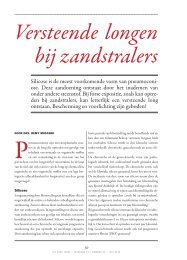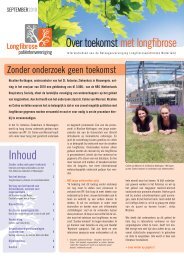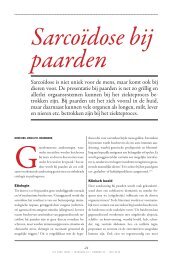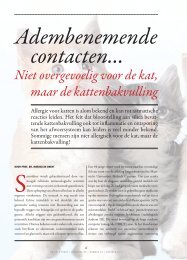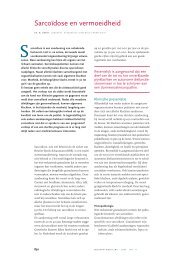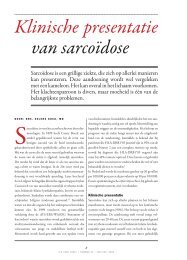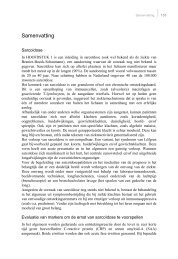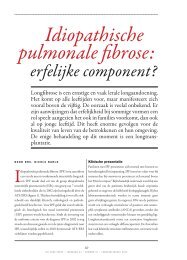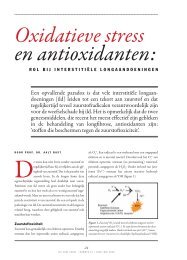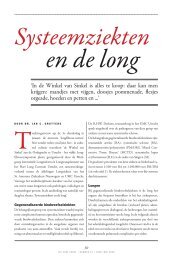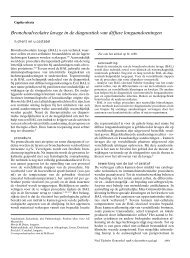Interpretation of bronchoalveolar lavage fluid cytology - ILD care
Interpretation of bronchoalveolar lavage fluid cytology - ILD care
Interpretation of bronchoalveolar lavage fluid cytology - ILD care
Create successful ePaper yourself
Turn your PDF publications into a flip-book with our unique Google optimized e-Paper software.
Table 1. - Characteristics <strong>of</strong> the study subjects.<br />
Groups n m* Age Female Male NSm Sm<br />
<strong>Interpretation</strong> <strong>of</strong> BALF <strong>cytology</strong><br />
Controls 30 0 33 (21-55) 15 15 15 15 (14.9±8.8)<br />
Learning set<br />
Sar 193 3 35 (18-79) 96 94 145 45 (15.7±7.8)<br />
EAA 39 1 50 (23-78) 14 24 34 4 (12.8±6.9)<br />
IPF 45 1 60 (30-79) 16 28 27 17 (18.0±5.1)<br />
Test set<br />
Sar 91 0 37 (17-77) 55 36 79 12 (15.7±6.1)<br />
EAA 5 0 52 (40-66) 1 4 3 2 (20.0±5.0)<br />
IPF 32 0 66 (50-79) 6 26 21 11 (17.4±8.1)<br />
Definition <strong>of</strong> abbreviations: m=missings, *missing at least one discriminating variable and thus not used in analysis;<br />
Mean with range in parentheses; NSm=Nonsmokers; Sm=Smokers; Number <strong>of</strong> smokers, mean number <strong>of</strong> cigarettes a<br />
day ± standard deviation in parentheses; Sar=sarcoidosis; EAA=extrinsic allergic alveolitis; IPF=idiopathic pulmonary fibrosis.<br />
In order to test the predictive power <strong>of</strong> the computer program based on the logistic model fitted in the learning set<br />
described previously, we used a set <strong>of</strong> 128 patients from another hospital (i.e., the Rijnstate Hospital, Arnhem, the<br />
Netherlands) who had sarcoidosis, EAA, or IPF. The diagnostic procedures used for this test population were<br />
comparable with those for the population that we used to develop the computer program (the learning set). In<br />
summary, the diagnoses <strong>of</strong> sarcoidosis and IPF were proven histologically by biopsy, and the diagnosis <strong>of</strong> EAA was<br />
confirmed by clinical information, chest radiography, pulmonary function testing, the presence <strong>of</strong> precipitins in<br />
peripheral blood, and the disappearance <strong>of</strong> the symptoms after avoidance <strong>of</strong> the causative antigen, or, in some<br />
cases, after a short course <strong>of</strong> treatment with corticosteroids. Table 1 lists the characteristics <strong>of</strong> the control subjects<br />
and patient groups studies. The study was approved by the ethical committees <strong>of</strong> both participating hospitals.<br />
Bronchoalveolar <strong>lavage</strong><br />
As reported previously [1], BAL was performed during fiberoptic bronchoscopy. Because the BAL procedure was<br />
the same in both hospitals, the results were fully comparable. The patients were premedicated with atropine and<br />
sometimes diazepam or codeine, and given local anaesthesia <strong>of</strong> the larynx and bronchial tree (tetracaine 0.5%).<br />
BAL was performed by standardized washing <strong>of</strong> the middle lobe with four 50-mL aliquots <strong>of</strong> sterile saline (0.9%<br />
NaCl) at 37 o C. Peripheral blood samples were taken simultaneously.<br />
Recovered BALF was kept on ice in a siliconized specimen trap, and was separated from cellular components by<br />
centrifugation (5 min, at 350 x g). Supernatants were directly stored at -70 o C after an additional centrifugation step<br />
(10 min, at 1,000 x g). Cells were washed twice, counted, and suspended in minimal essential medium (MEM; Gibco,<br />
Grand Island, NY) supplemented with 1% bovine serum albumin (BSA; Organon Teknika, Boxtel, the Netherlands).<br />
Preparations <strong>of</strong> cell suspensions were made in a cytocentrifuge (Shandon, Runcorn, UK). Cytospin slides <strong>of</strong><br />
BALF cells were stained with May-Grünwald-Giemsa (MGG; Merck, Darmstadt, Germany) for cell differentiation. At<br />
least, 1,000 cells were counted.<br />
Statistical methods<br />
In order to distinguish the three diagnostic groups from one another, a polychotomous logistic regression analysis<br />
[17,18] was done on the learning set, according to the following procedure: Each <strong>of</strong> the 277 patients in the learning<br />
set belonged to one and only one diagnostic group. Five <strong>of</strong> the cases (three sarcoidosis patients, one EAA patient,<br />
and one IPF patient) had at least one missing discriminating variable, and 272 cases were therefore used for the<br />
analysis. Of these, 190 patients belonged to the sarcoidosis group, 38 to the EAA group, and 44 to the IPF group<br />
(Table 1). Hence, an arbitrary patient within the total learning set had a probability <strong>of</strong> 190/272=0.70, 38/272=0.14<br />
S<strong>of</strong>tware to evaluate BALF analysis. Drent et al. Am J Respir Crit Care Med 1996.<br />
3



